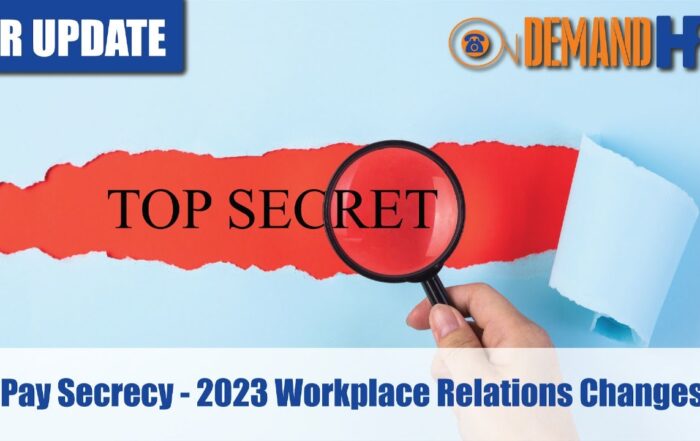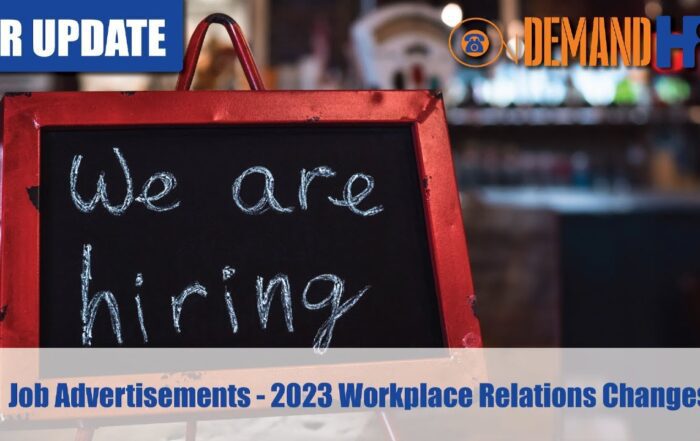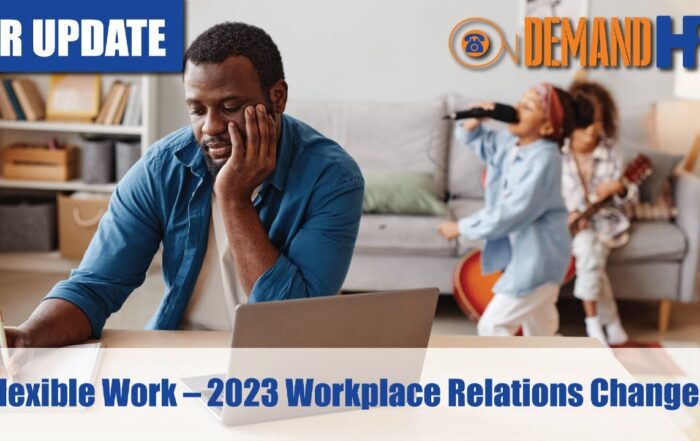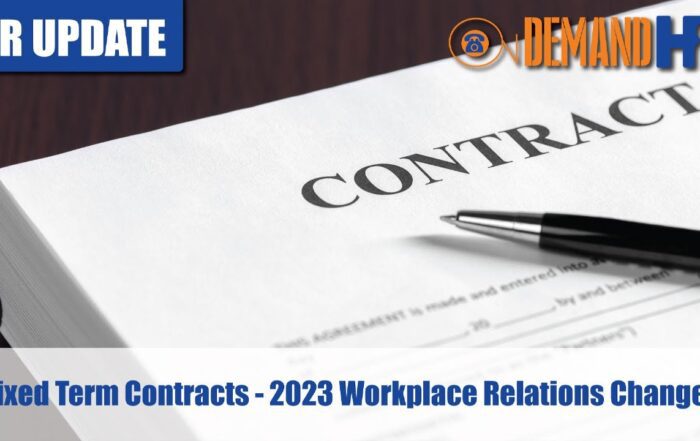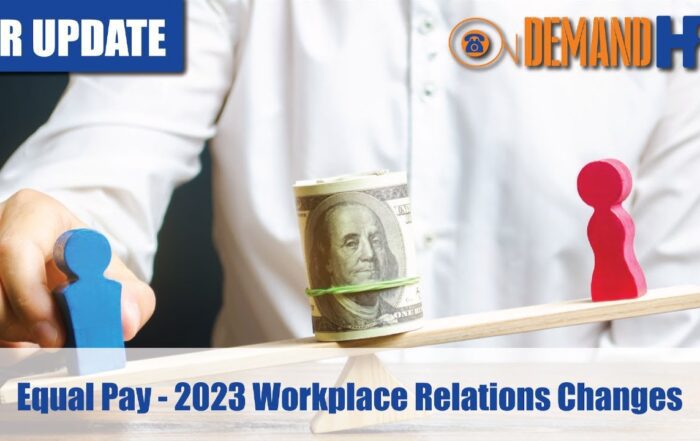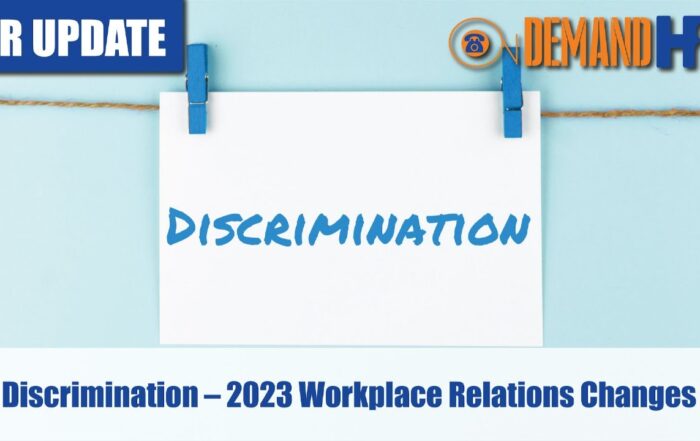Workplace Bullying, Discrimination & Sexual Harassment
In Episode 7 of HR Fridays where Clint talks about what constitutes workplace bullying, discrimination and harassment, but more importantly shares from his practical experience of what kinds of situations & circumstances are commonly mistaken by employees for being workplace bullying, discrimination and harassment
Please see below for a full transcript of the video
Share the HR or workplace relations challenge facing your business and one of our experienced consultants will be in touch within 24 hours with a strategic action plan or discover the best strategy yourself by accessing out free online training library.
Transcript
Clint Indrele 0:16
Good morning ladies and gentlemen. Welcome to another HR Fridays with Clint Indrele, Managing Director of On Demand HR. Hope you’ve all had a great week. Once again, we have a specific topic for all our viewers every single week. Let us know of any topics of interest. Please let us know any comments about today’s presentation, we’re happy to discuss your queries and answer them as we go and interact with us in relation to these sessions. The more interaction we get, the better. The whole purpose of this HR Fridays every week is trying to provide advice, which is based on reality. We’ve been in the Fair Work Commission many times we’ve done many workplace investigations, we’ve dealt with the Fair Work Ombudsman many times. This allows us to provide real perspective not just theory, and scare tactics that you may hear from other providers or other consultants. So for those who want more information about provision of our services www.ondemand hr.com.au.
Clint Indrele 1:15
Today’s topic is going to be about workplace bullying, harassment and discrimination. So we’re going to cover a few things in relation to these topics. very topical things are things that regularly come up in workplaces have been the subject of many of our workplace investigations over the years. On Demand HR has also got a fantastic training product that we are rolling out to our clients recently. And the one thing I’ll say about training in general, in relation to workplace bullying and harassment, you hear a lot about what complaints are, and why you should make a complaint, and when to make a complaint. And all these sorts of things. A lot of the training I find really focuses on the complaint complaint complaint, encouraging almost people to make complaints. Well, what we provide is quite different, we actually provide quite balanced training. And our training really goes into situations where you might consider maybe making a complaint or situations where you might consider taking self action, speaking to the individuals involved and situations where that don’t simply constitute workplace bullying, discrimination or harassment at all.
Clint Indrele 2:21
So today’s presentation, I really want to get focused on the basics. So just the definitions and you know, the simple, the simple things that are workplace bullying and harassment, and discrimination, and also the things that are commonly mistaken. So we’ll get straight into the presentation today.
Clint Indrele 2:39
So we’ll talk about workplace bullying, first of all, which is probably around about 80% of the various complaints that we deal with. So this seems to be the most topical one. And basically, workplace bullying is as defined by the Fair Work Act repeatedly repeated unreasonable behavior directed towards a worker or group of workers whilst at work, the behavior must create an ongoing risk to health and safety, and there must be a risk that behavior is likely to continue. So the sorts of things that we find that could potentially be deemed as workplace bullying are things like aggressive intimidating, or humiliating conduct or comments, teasing practical jokes, or initiations, unreasonable exclusion from work related events, spreading malicious rumors, and unreasonable work expectation.
Clint Indrele 3:24
So we see a lot of complaints along these sorts of lines over the years. The one thing we do also see very, very commonly, is situations where employees are being managed by their managers because of, you know, poor performance, poor conduct, poor behavior, whatever it may be, and as a response to that a complaint is made against the manager. So my general view of those type of complaints is that normally, that is a pretty weak starting point for a complaint that if a person has been subject to disciplinary action, and that has happened for some time, and then as a result, or not as a result, but but following that a complaint made against the manager. Typically, what you will find is one, the motivation for the complaint is often because the person simply doesn’t like being managed. And second of all, there’s a pretty good chance that whatever the conduct that is alleged in those situations, obviously, depending on circumstances, may not constitute workplace bullying. So that’s a common mistake we see in the mind of complainants. We also see a lot of complainants, to be fair, that are simply using complaints as a vehicle to being avoided to avoiding you know, basically performance management or being disciplined on their unsatisfactory conduct. So, that is something we are seeing. And particularly, I think this has become more of a generational thing that people just don’t accept criticism or feedback as well as perhaps they used to, and we’re seeing this prevalent in a lot more workplace situations. So we might just leave the workplace bullying part of it there.
Clint Indrele 5:01
Let’s move on to discrimination very quickly. So discrimination is when a person is treated differently as a result of one or more of the following protected attributes. I want you to focus on the blue parts of this particular slide. So you’ve got about 12 different things, there race, color, sex, age, disability, marital status, and a range of other ones. And it’s important to know that in order for something to be discrimination, it must be based on a prohibited grounds. So, you know, in order to to make a complaint, which is a discrimination complaint, and for it to be even considered to be valid or worth investigating, there must be an allegation that one of these things is the reason that that person has been discriminated against. And typically, we see discrimination in either hiring decisions, people not being promoted, potential conduct towards a person in the workplace, that they might say, is as a result of a particular attribute. Typically, on this list, if I look at the 12, that come up, probably the most common ones, interestingly, are ones around pregnancy, we see that quite a bit coming up, we see sometimes around age or sex, those, those tend to be the top three, I would say. Surprisingly, race and color discrimination complaints, just from our experience, and not actually that common, we don’t actually see a lot of allegations of discrimination on those grounds. We sometimes see disability ones, as well. So probably age, age, pregnancy, sex and disability, they’re probably the top four. And then the other ones to a lesser extent. We don’t actually see that many on religion, to be quite honest, not not that many on political opinion, those sorts of things. Marital status, we’ve got a couple of those, but generally quite rare.
Clint Indrele 6:55
The reason I put four more down the bottom in red, is because these are actually potential grounds that an employer might discriminate on, but not necessarily unlawful. So we’ve actually got some clients that refuse to hire people because they are smokers. Now, some people might think that is very unfair, but others might form the view, well, you know, smokers take more breaks, generally unhealthier. And whether those views are valid or not, they’re not one of the protected attributes that was in the group that’s in the blue column. So simply not hiring someone or not promoting someone or making a decision on something based on a person being a smoker, that’s not an illegal form of discrimination. Same with prospective things like driver’s license, if someone applies for a role, they don’t have transport, don’t have a driver’s license to carry out the role, or simply don’t have the required attributes. So that would be a fairly reasonable and lawful basis for discrimination. If you’ve got a customer service position, and you know, you’d need a certain level of communication skills in order to deliver in that particular role, that would be another one where it’d be quite reasonable to discriminate against someone based on the level of communication skills they have. And there’s a number of other situations where a person might not be able to perform the key requirements of the job. And as a result, inadvertently, they are being inadvertently they’ve been discriminated against in that selection process. So that’s just some examples of some quite lawful and quite reasonable discriminatory grounds, remembering that the unlawful ones are only in the blue column.
Clint Indrele 8:29
So let’s continue with sexual harassment. So this is one that comes up from time to time. Interestingly, in the complaints we deal with not as common as you think I mean, as I said earlier in the presentation, 80% or more of our complaints that we deal with are generally workplace bullying, and probably discrimination, fraud and sexual harassment probably makes up the remaining 15 to 20% of those complaints. So sexual harassment, first of all, by definition, is unwelcome sexual conduct, which makes a person feel offended, humiliated, and or intimidated and where that reaction is reasonable in all of the circumstances. It does not include sexual interaction, flirtation, attraction or friendship, which is invited, mutual, consensual or reciprocated. So yes, so we sometimes see this. The common ones we see in terms of matters that are generally investigated around comments. We don’t generally see that many that are in terms of touching or you know, things where there’s been, you know, touching or groping, occasionally get those ones but those are the kind of the probably the more serious end sexual harassment complaints. Generally, the ones that are gray areas are around things like comments, jokes. Sometimes as well you have a situation where there is a degree of, you know, it might be mutual flirtation, interaction at some point and then that turns and changes into those things not being mutual or reciprocated anymore. So that’s a common one that we sometimes get.
Clint Indrele 10:02
We also see ones from time to time in, you know, SMS messages or Facebook messages and things like that when parties are communicating in a certain way outside of work, obviously, this brings a broader question about how you should use social media when interacting with colleagues at work. You know, if you’re connecting with people on Facebook, on LinkedIn, well, then what level of what invitation does that provide to have conversations that are not of, you know, a strict work nature. Very tough line there, and a very gray area to consider in how you’re dealing with these particular things. So that’s a bit about really sexual harassment and what it is, and typically, you know, those are the sorts of common complaints that we see in that regard.
Clint Indrele 10:51
So I guess really the message out of today’s presentation, more than anything else is, I think it’s very important for all of your employees. First of all, to understand these three concepts. And we recommend that that in one of two ways, we recommend, first of all, as an absolute fundamental, that you obviously have, you know, appropriate policies and procedures to define these things and make it clear to employees what behaviors are acceptable and unacceptable in these particular areas.
Clint Indrele 11:18
The second thing that we are now recommending to our clients is to conduct training, conduct workplace bullying, discrimination and sexual harassment training, we actually are offering a new product to On Demand HR clients and anyone else who might be interested for a very nominal fee. And basically, it is a very, very affordable fee per person. Why this is preferable to you know, face to face facilitator is obviously with face to face facilitators, every time you get a new person, effectively, you’re going to have to bring out a facilitator in in a few months to, to deal with that person again or to you know, train new people, and you’re going to have regular turnover. The good thing about our product is that you know, it can be sort of turned on when you need it, you can obviously buy a number of I guess subscriptions in bulk, use them as you see fit. And obviously add on new starters, as you see fit as well.
Clint Indrele 12:12
Importantly, our training will go into areas such as taking self action. So automatically, people think, oh, if I’ve got a complaint, or if I’ve got a problem, I just have to make a complaint. And that’s the way to fix it. What we’re trying to encourage employees is where it’s appropriate to actually confront the individual, you know, who was responsible for the behavior, which you were dissatisfied with. And what that actually can do sometimes is give you a better long term result. Making a complaint often leads to a formal process, either either conducted internally or externally, can make parties feel very, very uncomfortable. And sometimes the parties don’t get the outcomes they want anyway. So often taking self action, just telling someone that you are offended or not happy with the way they have been behaving towards you, is actually better received than actually making a complaint in first instance. Now, sometimes that’s not appropriate, you do need to escalate these things, depending on the severity, and so on. But don’t discount taking self action.
Clint Indrele 13:07
The second thing that we’d like to also communicate to employees of clients is situations where they might feel unhappy or uncomfortable, but are not workplace bullying, discrimination and sexual harassment. And these are common things like if they’re being managed in relation to their performance if they disagree with the performance management, just because you disagree with a manager’s view on your performance doesn’t make that workplace bullying and harassment at the end of the day. Your managers view of your performance and your view might be different. But ultimately, you know, the manager, if they communicate that your performance is unacceptable and not to the required standards, then that doesn’t constitute workplace bullying and harassment and you’re probably wasting your time, frankly, making a complaint about those things. In my experience, those types of complaints generally lead nowhere and are generally unsubstantiated when you when you conduct a formal investigation, obviously, you look if you’ve got a matter that is very serious and you want an external person to conduct an investigation, you can also contact On Demand HR in relation to those services.
Clint Indrele 14:09
I think that’s pretty much a wrap for workplace bullying, discrimination and sexual harassment today, so if anyone’s got any questions or comments, feel free to leave them in the comment box and we’re happy to reach out to you another time. Feel free to refer this video on to your friends or professional colleagues for them to have a look at. Once again, thank you very much for joining us this Friday at HR Fridays. My name is Clinton Indrele, Managing Director of on demand HR once again, our website www.ondemandhr.com.au you have a great weekend everyone and once again, it’s goodbye for now.

